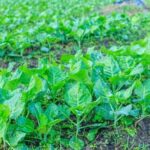Introduction: What is AC2 Treated Lumber?
When it comes to constructing structures or creating landscaping features, AC2 treated lumber has become a popular choice for many homeowners and gardeners. However, when it comes to using this type of lumber in vegetable gardens, concerns about its safety arise. In this article, we will explore the topic of AC2 treated lumber’s suitability for vegetable gardens and shed light on the potential risks and benefits associated with its use.
AC2 treated lumber refers to wood that has been treated with chemicals to enhance its durability and resistance against decay, rot, and insect damage. The acronym “AC2” stands for “Above Ground Contact,” indicating that this type of treated lumber is suitable for above-ground applications such as decks and fences. It is typically pressure-treated or kiln-dried after treatment to ensure optimal preservation.
This type of lumber is widely used in both construction and landscaping projects due to its ability to withstand harsh weather conditions and prolong the lifespan of wooden structures. Whether it’s building raised beds for vegetable gardens or installing garden borders, AC2 treated lumber offers practicality and longevity.
However, the question remains: Is it safe for growing vegetables? Throughout this article, we will weigh the potential risks against the benefits of using AC2 treated lumber in vegetable gardens, empowering readers to make informed decisions about their gardening practices.
Understanding the Potential Risks
AC2 treated lumber is a type of wood that has been pressure-treated with chemicals to increase its durability and resistance to decay and insects. While AC2 treated lumber is commonly used in construction and landscaping projects, there are concerns about its safety when used in vegetable gardens. In this section, we will delve into the potential risks of using AC2 treated lumber in vegetable gardens and explore the chemicals used in the treatment process.
Chemicals Used in AC2 Treatment
One of the main chemicals used in AC2 treatment is alkaline copper quaternary (ACQ). ACQ contains copper, which acts as a fungicide and helps prevent the wood from rotting or decaying. Other chemicals such as quat biocides are also added to deter insect damage. These chemicals are intended to prolong the lifespan of the wood, making it suitable for outdoor applications.
Potential Risks to Vegetable Gardens
While ACQ-treated lumber provides benefits in terms of durability and longevity, there are concerns about its use in vegetable gardens due to potential chemical leaching. The copper present in ACQ-treated wood can gradually leach into the surrounding soil over time. The amount of leaching depends on factors such as soil moisture levels, pH, and temperature.
The potential risks associated with using AC2 treated lumber in vegetable gardens include:
- Copper Accumulation: High levels of copper can be toxic to plants or inhibit their growth. Copper can accumulate in vegetables grown in soil near ACQ-treated wood if leaching occurs.
- Soil Quality: Copper leaching can affect soil quality by altering its pH balance or disrupting beneficial microbial activity. This may impede nutrient uptake by plants or create an inhospitable environment for beneficial organisms.
It is essential for gardeners to consider these potential risks before using AC2 treated lumber within their vegetable gardens. Taking precautionary measures and understanding how these chemicals can impact plant health and soil quality is crucial for making informed decisions.
Research and Expert Opinions
When it comes to using AC2 treated lumber in vegetable gardens, there is a range of research studies and expert opinions that offer insights into its safety. While some experts believe that the chemicals used in AC2 treatment can pose risks to vegetable gardens, others argue that with proper precautions, it can be safely used.
It is important for gardeners to consider these differing viewpoints and make an informed decision about whether to use AC2 treated lumber in their vegetable gardens.
One study conducted by the University of Illinois found elevated levels of copper and other chemicals in the soil near raised beds made from AC2 treated lumber. Copper is one of the primary chemicals used in AC2 treatment, and while it is an essential nutrient for plants at low levels, excessive amounts can be harmful. The study concluded that prolonged exposure to high levels of copper from AC2 treated lumber could potentially have negative effects on plant growth and health.
On the other hand, proponents of using AC2 treated lumber argue that when used properly and with certain precautions, the risks can be minimized. The American Wood Protection Association suggests several measures to minimize potential risks, such as lining the inside of raised beds with plastic sheeting or using a thick layer of landscape fabric as a barrier between soil and treated wood.
These measures can help prevent direct contact between the soil and the chemicals in the lumber, reducing the chances of leaching into the soil.
It’s also crucial for gardeners who choose to use AC2 treated lumber to monitor their vegetable gardens closely for any signs of possible harm. Regular soil testing can help identify any excessive accumulation of chemicals over time. Some experts recommend opting for vegetables with shallow root systems or ones that are less likely to take up chemical compounds from the soil, as an additional precautionary measure.
Environmental Impact
AC2 treated lumber, while offering benefits in construction and landscaping, may have potential long-term effects on soil health and plant growth in vegetable gardens. The chemicals used in AC2 treatment can leach into the surrounding soil, raising concerns about their impact on the environment and edible crops. This section will discuss the potential environmental impacts of AC2 treated lumber and how it may affect the health and productivity of vegetable gardens.
One of the main concerns with AC2 treated lumber is the leaching of chemicals into the soil. The copper-based preservatives used in AC2 treatment are known to slowly release copper ions over time, which can accumulate in the soil. Elevated levels of copper can be toxic to plants, affecting their growth and overall health. Additionally, these chemicals can potentially contaminate groundwater if not properly managed.
To mitigate these risks, it is important to consider factors such as leaching rate, proximity to edible crops, and frequency of exposure. Research suggests that leaching rates decrease over time, so using older or weathered AC2 treated lumber may pose a lower risk than newly installed materials. It is also advisable to maintain a safe distance between treated lumber and edible crops by using raised beds or liners as a barrier.
Gardeners should also be mindful of plant selection when using AC2 treated lumber in their vegetable gardens. Some plants are more tolerant to copper toxicity than others. For example, leafy greens like spinach and lettuce are more susceptible to copper accumulation compared to root vegetables like carrots or potatoes.
Precautionary Measures
Tips for Safe Handling and Installation
When using AC2 treated lumber in vegetable gardens, it is important to take proper precautions to minimize potential risks. One of the first steps is to ensure safe handling and installation of the lumber. Here are some tips to keep in mind:
- Wear protective gloves and a dust mask when handling AC2 treated lumber to prevent direct skin contact and inhalation of any potential chemicals.
- Use appropriate tools, such as corrosion-resistant fasteners, to avoid reactions between the material and the metals used.
- Avoid cutting or sanding the lumber indoors or in enclosed spaces without proper ventilation. Sawdust from treated lumber can release harmful chemicals into the air.
- Clean up any loose sawdust or debris promptly to reduce the risk of unintentional ingestion by children or pets.
Creating Protective Barriers
Another precautionary measure that gardeners can take is creating protective barriers between AC2 treated lumber and their vegetable plants. This can help reduce direct contact with the soil and minimize potential leaching of chemicals. Some methods include:
- Using a plastic liner between the treated wood and the soil in raised beds or containers.
- Installing geotextile fabric as a barrier under ground-level installations, such as pathways, to prevent direct contact with soil.
- Avoiding direct planting into AC2 treated lumber structures by growing vegetables in separate containers or pots.
These measures can act as an extra layer of protection, providing peace of mind for those concerned about possible chemical exposure.
Considering Alternative Options
For individuals who want to avoid any potential risks associated with AC2 treated lumber, there are alternative options available for constructing raised beds or other garden structures. Some safer alternatives include:
- Cedarwood: Known for its natural resistance to decay and insects, cedarwood is a popular choice for organic gardening due to its durability and lack of chemical treatments.
- Composite materials: Made from a combination of recycled plastic and wood fibers, composite lumber offers similar functionality to treated lumber but without the use of chemicals.
- Landscaping bricks or stones: These can be used to create raised beds or garden borders, providing a long-lasting and visually appealing alternative.
By exploring these alternative options, gardeners can still enjoy the benefits of using durable materials while minimizing their exposure to potentially harmful chemicals found in treated lumber.
Alternatives to AC2 Treated Lumber
When it comes to constructing raised beds or garden structures in vegetable gardens, there are alternative materials that can be used instead of AC2 treated lumber. These alternatives provide safer options for gardeners who are concerned about the potential risks associated with AC2 treated lumber.
One popular alternative is untreated cedar or redwood lumber. Cedar and redwood are naturally resistant to insects and decay, making them durable choices for garden construction. These types of wood also have a pleasant scent and attractive appearance, adding aesthetic value to the garden. However, it is important to note that untreated wood may still break down over time and require periodic replacement.
Another option is composite lumber made from recycled materials such as plastic and wood fibers. Composite lumber offers several advantages, including resistance to rot, insect infestation, and warping. It is a long-lasting choice that requires minimal maintenance, making it ideal for vegetable gardens. Additionally, composite lumber comes in various colors and styles, providing flexibility in design.
Lastly, metal materials such as galvanized steel or aluminum can be used as an alternative to AC2 treated lumber. Metal lasts longer than wood and does not deteriorate or attract pests like termites. It is incredibly strong and can withstand harsh weather conditions. Although metal may get hot under direct sunlight, this can be mitigated by applying a layer of paint or using light-colored materials.
Using these alternatives can provide peace of mind for gardeners who want to avoid the potential risks associated with AC2 treated lumber without sacrificing the durability and functionality of their garden structures.
| Alternative Material | Advantages |
|---|---|
| Untreated Cedar or Redwood Lumber | Naturally resistant to insects and decayAttractive appearanceMinimal maintenance |
| Composite Lumber | Resistance to rot, insect infestation, and warpingLow maintenanceVarious colors and styles |
| Metal Materials (galvanized steel or aluminum) | Durable and long-lastingResistant to deterioration and pestsStrong construction |
Organic Gardening Practices
One of the best ways to ensure the safety and sustainability of your vegetable garden is by practicing organic gardening methods. Organic gardening eliminates the use of synthetic chemicals, including those that may be present in AC2 treated lumber. By following organic practices, you can create a healthy and environmentally-friendly garden that promotes biodiversity and supports beneficial organisms.
One fundamental principle of organic gardening is focusing on soil health. Building and maintaining fertile soil is key to growing nutrient-rich vegetables without relying on chemical fertilizers. This can be achieved by incorporating organic matter such as compost or well-rotted manure into the soil, which improves its structure, drainage, and nutrient content.
Companion planting is another essential aspect of organic gardening. By strategically placing compatible plants together, you can help deter pests naturally and improve overall garden health. For example, planting marigolds near your vegetable crops can repel nematodes, while herbs like basil and dill attract beneficial insects that feed on pests.
In addition to soil health and companion planting, proper watering techniques are crucial for organic gardening success. Watering deeply at the base of plants encourages strong root development and reduces excessive evaporation. It’s also important to use organic pest control methods such as handpicking pests off plants, using physical barriers like row covers, or making natural sprays with ingredients like neem oil or garlic.
By employing these organic gardening practices, you can create a safe and sustainable vegetable garden without the need for AC2 treated lumber or any other potentially harmful materials. Not only will you enjoy healthy and nutritious produce, but you’ll also contribute to a healthier ecosystem by minimizing chemical usage.
| Organic Gardening Practices | Description |
|---|---|
| Focus on Soil Health | Incorporate organic matter into the soil to improve structure and nutrient content |
| Companion Planting | Strategically plant compatible species together to deter pests and promote healthy growth |
| Proper Watering Techniques | Water deeply at the base of plants to encourage strong root development and reduce evaporation |
| Organic Pest Control | Use natural methods and ingredients to control pests without relying on synthetic chemicals |
Case Studies and Personal Experiences
One way to gain insight into the safety of AC2 treated lumber in vegetable gardens is by examining case studies and personal experiences of gardeners who have used this material. While research studies and expert opinions provide valuable information, real-life examples can offer practical perspectives and highlight any potential issues or successes.
Several gardeners have shared their experiences with using AC2 treated lumber in their vegetable gardens. These stories vary, with some reporting no negative effects on their plants or produce, while others have experienced adverse outcomes. One common issue mentioned by those who experienced negative effects is the leaching of chemicals from the treated wood into the soil, which can lead to contamination of vegetables.
One gardener, Emily, used AC2 treated lumber to build raised beds for her vegetable garden. Initially, she was pleased with the durability and ease of construction. However, after a few months of using the raised beds, she began to notice stunted growth and discoloration in her tomato plants. Further investigation revealed that chemicals from the treated wood were leaching into the soil and affecting plant health. This experience prompted her to switch to alternative materials for her garden structures.
These case studies highlight the importance of considering individual experiences when deciding whether to use AC2 treated lumber in vegetable gardens. While some have had positive outcomes, others have faced challenges related to chemical leaching and potential harm to plants or produce. Gardeners should carefully weigh these personal accounts alongside scientific research and expert opinions before making an informed decision about using AC2 treated lumber in their own gardens.
Conclusion
In conclusion, the decision to use AC2 treated lumber in vegetable gardens requires careful consideration of the potential risks and benefits. While AC2 treated lumber offers durability and longevity for garden structures, it also poses potential risks due to the chemicals used in its treatment. Research studies and expert opinions are conflicting on whether AC2 treated lumber is safe for vegetable gardens, highlighting the need for individual assessment and precautionary measures.
To minimize potential risks, gardeners can take precautionary measures such as using protective barriers or liners when using AC2 treated lumber in their vegetable gardens. Additionally, exploring alternative materials for raised beds or garden structures can provide safer options without compromising on durability. By considering these alternatives, gardeners can create a safe and sustainable environment for their vegetable gardens.
Furthermore, organic gardening practices offer an alternative approach that eliminates the need for treated lumber altogether. By focusing on natural methods such as composting, crop rotation, and using organic fertilizers, gardeners can maintain healthy soil and promote plant growth without relying on potentially harmful materials.
Ultimately, making an informed decision about using AC2 treated lumber in vegetable gardens requires weighing the potential risks against the benefits. It is important to consider all factors including research findings, expert opinions, precautionary measures, alternative options, and personal experiences of others. By taking a comprehensive approach and prioritizing safety and sustainability, gardeners can make choices that align with their values while ensuring a thriving vegetable garden for years to come.
Frequently Asked Questions
Is AC2 pressure treated lumber safe?
AC2 pressure treated lumber is generally considered safe for most applications, including outdoor use. The “AC2” refers to alkaline copper quat, which is a type of preservative used to protect the wood against decay and insect damage.
This treatment involves the infusion of copper-based compounds into the wood fibers, providing long-lasting protection. While there have been concerns in the past regarding the safety of pressure-treated lumber due to its content of chemicals like arsenic, modern treatments such as AC2 are generally deemed safe for residential use.
Is CA C pressure treated wood safe for vegetable gardens?
CA C pressure treated wood can be used safely in vegetable gardens, although it is important to take some precautions. CA C typically stands for copper azole, which is another preservative that is commonly used in pressure-treated wood products. Copper azole contains copper as a key component to deter insects and fungal decay.
However, it’s crucial to ensure that direct contact between the treated wood and edible plant parts (such as roots or leaves) is avoided. This can be achieved by lining the interior walls of raised beds with plastic sheeting or burying the bottom portion of posts.
Is treated lumber safe for raised vegetable beds?
Treated lumber can be safe for use in raised vegetable beds as long as certain precautions are taken. Raised beds provide an additional layer of protection since they minimize contact between soil and potentially harmful substances present in treated lumber. It’s essential to choose a treatment that is specifically designed for raised bed gardening, such as using non-toxic alternatives like naturally rot-resistant woods (e.g., cedar or redwood) or untreated hardwoods (e.g., oak or locust).
If using pressure-treated lumber, opting for newer formulations like copper azole instead of older treatments containing arsenic offers a safer option. Additionally, lining the interior walls with plastic sheeting creates a barrier between the soil and the treated wood, further reducing any potential risk.

If you’re looking to get into vegetable gardening, or are just looking for some tips on how to make your current garden better, then you’ve come to the right place! My name is Ethel and I have been gardening for years. In this blog, I’m going to share with you some of my best tips on how to create a successful vegetable garden.





